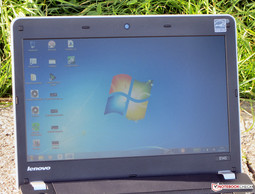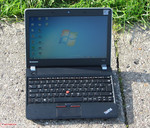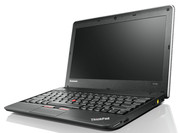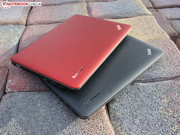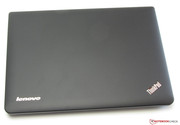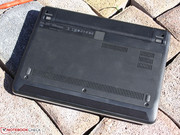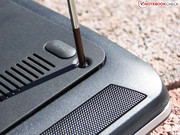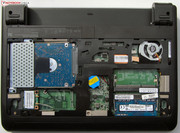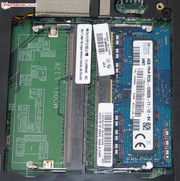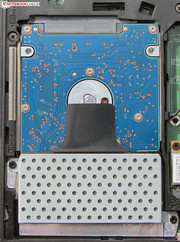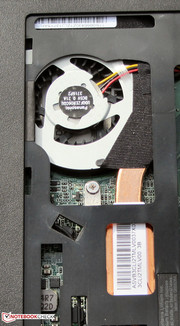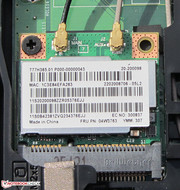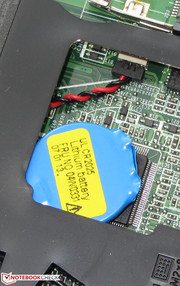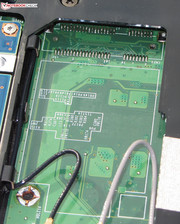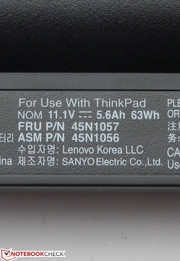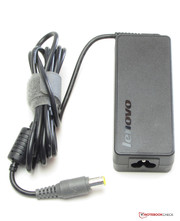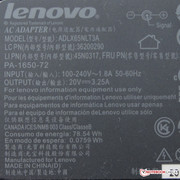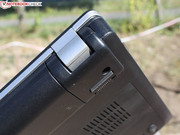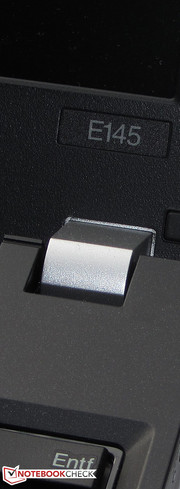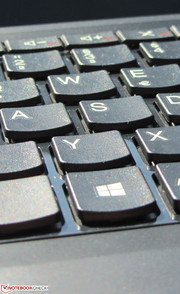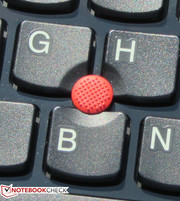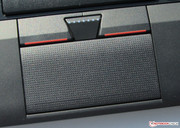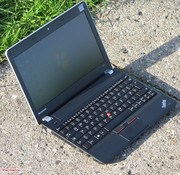Review Lenovo ThinkPad Edge E145 Notebook

For the original German review, see here.
Lenovo's ThinkPad Edge line is conceived as a series of inexpensive notebooks that still offer ThinkPad quality. Lenovo has been successful in this endeavor, at least to some extent. As the newest member of the family, the ThinkPad Edge E145 is also intended to fulfill this role. The computer will look familiar to many readers, as its build is identical to that of its predecessor -- the ThinkPad Edge E135 (AMD E2-1800, Radeon HD 7340) -- and of its Intel counterpart, the ThinkPad Edge E130. We recently reviewed two members of the line: the ThinkPad Edge E130 NZUAXMB (Core i3-3227U, HD Graphics 4000) and the ThinkPad Edge E130 NZU5FGE (Pentium 977, HD Graphics (Sandy Bridge)). Can the Edge 145 hold on to the same good rating as its predecessor? Our review holds the answer.
To position the notebook relative to its competition, we'll discuss how it compares to the Acer Aspire V5-131-10172G50akk (Celeron 1017U, HD Graphics (Ivy Bridge)) and the Lenovo IdeaPad S210 Touch (Pentium 2127U, HD Graphics (Ivy Bridge)).
Because the ThinkPad Edge E145 is structurally identical to the Edge E135 and E130, we won't elaborate on its case, input devices, connectivity or speakers. You can find information about those components of the device in our reviews of the Edge E135, Edge E130 NZUAXMB and Edge E130 NZU5FGE.
Operating System
Windows 7 Pro (64-bit) runs on our test device. There are currently two versions of the Edge 145 on the market. The first model comes with the operating system FreeDOS. The second model has a preinstalled version of Window 7 Pro. This computer also has a Windows 8 Pro recovery DVD (including COA) so that it can be updated to Windows 8.
Display
Like its siblings, the Edge E145 is also equipped with a matte 11.6-inch display. The display has a native resolution of 1366x768 pixels and a good average brightness of 266.1 cd/m². At that value, the E145 clearly outstrips its three siblings. The Aspire (194.4 cd/m²) comes in considerably far behind the ThinkPad Edge. The IdeaPad (238.4 cd/m²) can't quite keep up either.
| |||||||||||||||||||||||||
Brightness Distribution: 86 %
Center on Battery: 294 cd/m²
Contrast: 330:1 (Black: 0.89 cd/m²)
ΔE ColorChecker Calman: 11.14 | ∀{0.5-29.43 Ø4.78}
ΔE Greyscale Calman: 11.48 | ∀{0.09-98 Ø5}
40.51% AdobeRGB 1998 (Argyll 3D)
58.8% sRGB (Argyll 3D)
39.2% Display P3 (Argyll 3D)
Gamma: 2.1
CCT: 12680 K
The display's contrast (330:1) and black value (0.89 cd/m²) leave something to be desired. The IdeaPad (260:1, 1.01 cd/m²) offers even less; the Aspire's numbers (444:1, 0.43 cd/m²) are at least acceptable. The ThinkPad Edge can't cover the AdobeRGB or sRGB color spaces. It covers about 52% of the sRGB color space. Color spaces play a role in professional image processing.
The average DeltaE 2000 deviation is 11.14. The deviations in dark tones, the grayscale and reds and blues exceed this number. No color falls within the target (DeltaE less than 5). The display also has a blue cast.
Outdoor use is definitely possible with the E145. Thanks to its good brightness and matte surface, the display is still easily visible out in the sunshine.
The device's viewing angle stability is no different from the majority of inexpensive notebooks. If you change the vertical viewing angle, the image quickly degrades. There's more room to play around with the horizontal angle: It's easy to read the screen's content from the side, though the image grows darker at greater angles.
Performance
The ThinkPad Edge 145 models are very mobile and hardy 11.6-inch notebooks. If you're looking for a device to use on the go -- or in the home or office -- for writing texts, surfing the internet (you'll need a 3G or 4G stick) or watching videos, you'll get what you need with the Edge 145. The computer can play videos in up to Full HD resolution. The Radeon graphics card is equipped with the necessary decoder for Full HD videos. During Full HD video playback, the DXVA Checker tool records an average CPU and GPU load of 11 and 93% respectively.
Our test device currently costs about 460 Euros (~$625). Without the Windows operating system, the notebook can be purchased for a low 350 Euros (~$475). As was true of its predecessor, Lenovo offers the Edge E145 with either a red or a black display lid. The company provided us with both color options for our review. Anyone who would be satisfied with the performance level of the 145's predecessor can still opt for the Edge E135. The older model currently costs about 290 Euros (~$395) without the Windows operating system.
Processor
Lenovo installs the AMD E1-2500 APU in their Edge 145. This APU is part of the new Kabini generation. The CPU component of the APU is a dual-core processor with a speed of 1.4 GHz. There is no turbo. The whole APU has a TDP of 15 watts, which is a little lower than those of Intel's ULV processors. But in terms of CPU performance, the AMD APU can't keep up with these Intel CPUs. The direct predecessor of the E1-2500 APU, the E1-1200 (Zacate generation), works at the same clock frequency.
The CPU runs the Cinebench benchmark's CPU tests at full speed (1.4 GHz). The Edge E145 can't quite keep up with the Aspire (Celeron 1017U, HD Graphics (Ivy Bridge)) and the IdeaPad (Pentium 2127U, HD Graphics (Ivy Bridge)). However, we didn't expect anything more of our test device's CPU, as the AMD CPU lies at least one performance class below those of the Intel processors. However, the E1-1200 APU -- at work in the IdeaPad S206, for instance -- comes in considerably far behind ours. The E1-1200 APU's computation results prove to be an average of about 20% worse than those of our AMD APU. AMD managed to significantly improve their lower class APU's performance -- even at the same clock frequency.
Lenovo installed an E2-1800 APU (1.8 GHz; Zacate generation) in the predecessor of the Edge 145, the Edge E135. The Edge E145 exceeds the Edge 135's results by a moderate margin. Compared with other notebooks equipped with the E2-1800, the Edge E145's results are only minimally stronger. With its Kabini architecture, AMD reaches the same CPU performance as the 400 MHz faster E2-1800 APU. Our ThinkPad Edge dominates the Cinebench R11.5 GL tests: Among the three competing devices, it clearly has the strongest GPU.
| Lenovo ThinkPad Edge E145 Radeon HD 8240, E1-2500, Hitachi Travelstar Z5K500 HTS545050A7E380 | Lenovo Ideapad S206 M898UGE Radeon HD 7310, E1-1200, Seagate Momentus Thin ST500LT0 12-9WS142 | Lenovo ThinkPad Edge E135 NZV5YGE Radeon HD 7340, E2-1800, Hitachi Travelstar Z7K500 HTS725050A7E630 | Lenovo B575e Radeon HD 7340, E2-1800, WDC Scorpio Blue WD5000BPVT-00HXZT3 | |
|---|---|---|---|---|
| Cinebench R11.5 | -22% | -9% | -6% | |
| CPU Multi 64Bit (Points) | 0.66 | 0.52 -21% | 0.59 -11% | 0.64 -3% |
| CPU Single 64Bit (Points) | 0.35 | 0.27 -23% | 0.33 -6% | 0.32 -9% |
| Cinebench R10 | -19% | -4% | 0% | |
| Rendering Single 32Bit (Points) | 1052 | 888 -16% | 1110 6% | |
| Rendering Multiple CPUs 32Bit (Points) | 2016 | 1682 -17% | 2092 4% | |
| Rendering Single CPUs 64Bit (Points) | 1266 | 984 -22% | 1209 -5% | 1210 -4% |
| Rendering Multiple CPUs 64Bit (Points) | 2391 | 1887 -21% | 2319 -3% | 2270 -5% |
| Total Average (Program / Settings) | -21% /
-20% | -7% /
-6% | -3% /
-2% |
System Performance
Our impression of the overall system is somewhat weakened by its hard drive. The drive's high access time, combined with its sometimes below average transfer speeds, cause the system to start programs somewhat sluggishly. The Edge E135 had a considerably faster hard drive. Still, the E145's PCMark results prove to be respectable. The slow hard drive can't stop the E145 from doing a better job than its predecessor. The E145 can't keep up with the IdeaPad (Pentium 2127U, HD Graphics (Ivy Bridge)) and the Aspire (Celeron 1017U, HD Graphics (Ivy Bridge)). Both are equipped with stronger processors.
The installation of a Solid State Drive rids the Edge E145 of its problem with sluggishness. We tried it: The system starts up more quickly and runs fluidly. The improved PCMark scores also testify clearly to this. Our Solid State Drive (Crucial RealSSD C300 - 64 GB) increased the PCMark 7 results by about 67%, to 2092 points. The PCMark Vantage score rose by 45%, to 3412 points.
| PCMark Vantage Result | 2352 points | |
| PCMark 7 Score | 1254 points | |
| PCMark 8 Home Score Accelerated | 1418 points | |
| PCMark 8 Work Score Accelerated | 2338 points | |
Help | ||
Storage Devices
Our test device is equipped with a hard drive from the Travelstar-Z5K500 series by Hitachi. It has a capacity of 500 GB and runs at 5400 revolutions per minute. CrystalDiskMark records a read speed of 96.9 MB/s. HD Tune shows an average transfer rate of 77.3 MB/s. These numbers are reasonable for a 5400 rpm hard drive. At 22.1 ms, the access time is a little too high. The 4k read/write results also leave something to be desired. Many comparable hard drives offer better results. These numbers are relevant, as most files are stored in 4 kb-sized blocks. The Edge E135 could be upgraded with the installation of a considerably faster 7200 rpm hard drive. We expected one of these higher models in the E145.
Graphics Card
The Radeon HD 8240 graphics core takes care of graphics tasks. It runs at a speed of 400 MHz and supports DirectX 11.1. In terms of performance, the GPU falls between Intel's HD Graphics (Ivy Bridge) and HD Graphics 4000 graphics chips. This is verified by the 3DMark benchmarks. The ThinkPad Edge always scores best when the CPU has very little influence on the result, as we see in 3DMark 2011 and 3DMark Fire Strike, for example. In the rest of the 3DMark benchmarks, the IdeaPad (Pentium 2127U, HD Graphics (Ivy Bridge)) comes in ahead, due to the fact that it possesses the strongest processor. The Aspire (Celeron 1017U, HD Graphics (Ivy Bridge)) is on par with the Edge E145 in the rest of the 3DMark benchmarks.
The HD 8240 core can boldly compete with the Radeon HD 7310 and Radeon HD 7340 GPUs (at work in the E1-1200 and E2-1800 APUs respectively). It achieves considerably better results than its predecessors.
| 3DMark 05 Standard | 5118 points | |
| 3DMark 06 Standard Score | 2636 points | |
| 3DMark Vantage P Result | 1377 points | |
| 3DMark 11 Performance | 464 points | |
| 3DMark Ice Storm Standard Score | 18212 points | |
| 3DMark Cloud Gate Standard Score | 1501 points | |
| 3DMark Fire Strike Score | 272 points | |
Help | ||
Gaming Performance
The built-in APU lies in the lower segment of the performance scale and simply offers sufficient performance for everyday tasks. Modern 3D computer games don't belong in that category. Still, it's possible to play a game here or there at low resolution and low quality settings. Some of the playable titles include the popular StarCraft 2 and World of Warcraft. With APUs from the A series and Intel processors, a second working memory module can tickle a few more frames per second out of the device. The working memory would then run in dual-channel mode, where the integrated GPU can be used to its full potential. With the second module, the average frame rate rises by between 5 and 20% -- depending on the game. This effort would be fruitless in the case of the E135, as the built-in memory controller only supports single-channel mode.
| low | med. | high | ultra | |
|---|---|---|---|---|
| World of Warcraft (2005) | 46.7 | 33.7 | ||
| Trackmania Nations Forever (2008) | 59.8 | 18.5 | ||
| Racedriver: GRID (2008) | 30 | 23 | ||
| Sims 3 (2009) | 92.1 | 35.4 | ||
| Resident Evil 5 (2009) | 18.1 | 13.3 | ||
| Risen (2009) | 29.9 | 13.3 | ||
| Mafia 2 (2010) | 10.1 | 9.7 | ||
| Civilization 5 (2010) | 12.9 | |||
| Total War: Shogun 2 (2011) | 31.7 | 8.4 | ||
| Dirt 3 (2011) | 25 | 16.8 | ||
| Deus Ex Human Revolution (2011) | 28.7 | 13.3 | ||
| The Elder Scrolls V: Skyrim (2011) | 14.8 | 11.1 | ||
| Anno 2070 (2011) | 29.7 | 13.2 | ||
| Diablo III (2012) | 28 | 18.6 | ||
| Sleeping Dogs (2012) | 16.4 | 15.6 | ||
| Counter-Strike: GO (2012) | 21.1 | 19.2 | ||
| F1 2012 (2012) | 12 | 12 | ||
| Fifa 13 (2012) | 36.6 | 27.1 | ||
| Hitman: Absolution (2012) | 7.4 | |||
| Dead Space 3 (2013) | 34.2 | 14.9 | ||
| Tomb Raider (2013) | 21.8 | 11 | ||
| StarCraft II: Heart of the Swarm (2013) | 46 | 18.5 | ||
| BioShock Infinite (2013) | 20.8 | 10.5 | ||
| Metro: Last Light (2013) | 6.4 | |||
| GRID 2 (2013) | 18.7 | 12.6 | ||
| Company of Heroes 2 (2013) | 5 | |||
| Dota 2 (2013) | 12.3 | 10.1 | ||
| Fifa 14 (2013) | 28.6 |
| Lenovo ThinkPad Edge E145 Radeon HD 8240, E1-2500, Hitachi Travelstar Z5K500 HTS545050A7E380 | Acer Aspire V5-131-10172G50akk HD Graphics (Ivy Bridge), 1017U, Seagate Momentus Thin ST500LT0 12-9WS142 | Lenovo ThinkPad Edge E135 NZV5YGE Radeon HD 7340, E2-1800, Hitachi Travelstar Z7K500 HTS725050A7E630 | Lenovo IdeaPad S210 Touch 20257 HD Graphics (Ivy Bridge), 2127U, Seagate Momentus Thin ST500LT0 12-9WS142 | |
|---|---|---|---|---|
| Anno 2070 | -61% | -11% | -3% | |
| 1024x768 Low Preset (fps) | 29.7 | 11.1 -63% | 29 -2% | 28.4 -4% |
| 1366x768 Medium Preset AA:on (fps) | 13.2 | 5.5 -58% | 10.6 -20% | 13 -2% |
Emissions
System Noise
In idle mode, the E145's fan doesn't have much to do and remains stationary most of the time. As a result, the only potentially audible component is the hard drive. The sound pressure level lies between 30 and 31.4 dB. The numbers we recorded for the IdeaPad (30.7 to 31.4 dB) and the Aspire (29.8 to 31 dB) are on par with those of our review device. Under medium (3DMark06 running) and full load (stress test, Prime95 and Furmark all running), the ThinkPad Edge's pressure level rises to 32.8 dB and 35.1 dB respectively. Under full load, the Aspire (32.3 and 32.6) and the IdeaPad (32.4 and 32.5 dB) both prove to run more quietly.
Noise level
| Idle |
| 30 / 30 / 30 dB(A) |
| HDD |
| 31.4 dB(A) |
| Load |
| 32.8 / 35.1 dB(A) |
 | ||
30 dB silent 40 dB(A) audible 50 dB(A) loud |
||
min: | ||
Temperature
The Edge 145 is remarkable for its low heat development. For idle to full load, the temperatures on the outer surfaces of the notebook never even reach 30 °C (86 °F). In this discipline, the Aspire and IdeaPad can't keep up with the ThinkPad Edge. Both competing devices only reach moderate temperatures, but under full load they cross the 40 °C mark (104 °F). The Edge E145 surpasses its direct predecessor -- the Edge E135 -- as well: On average, the older model's case temperatures are about 10 °C (18 °F) higher.
The CPU performs the stress test (Prime95 and Furmark running for at least one hour) at full speed (1.4 GHz) both in AC power and battery mode. The graphics core runs the stress test at full speed (400 MHz) in AC power mode, but in battery mode it throttles down to 300 MHz. The latter can be altered in the driver menu so that the GPU also processes at 400 MHz in battery mode. The CPU temperature leveled off at about 68 °C (154.4 °F) in AC power mode.
(+) The maximum temperature on the upper side is 28.4 °C / 83 F, compared to the average of 35.9 °C / 97 F, ranging from 21.4 to 59 °C for the class Subnotebook.
(+) The bottom heats up to a maximum of 27.5 °C / 82 F, compared to the average of 39.3 °C / 103 F
(+) In idle usage, the average temperature for the upper side is 26.1 °C / 79 F, compared to the device average of 30.8 °C / 87 F.
(+) The palmrests and touchpad are cooler than skin temperature with a maximum of 26.8 °C / 80.2 F and are therefore cool to the touch.
(±) The average temperature of the palmrest area of similar devices was 28.2 °C / 82.8 F (+1.4 °C / 2.6 F).
Energy Management
Power Consumption
At 4.2 to 6.3 watts, the Edge 145's power consumption in idle mode proves to be very low. Neither the Aspire (4.5 to 7.3 watts) nor the IdeaPad (5.8 to 8 watts) can quite keep up here. Under medium load (3DMark06 running) and full load (stress test, Prime95 and Furmark running), the ThinkPad Edge only needs 14.9 and 20.1 watts respectively. The Aspire (20.3 and 24.7 watts) and the IdeaPad (23.7 and 27.6 watts) require more energy. One ought not to forget, however, that both of the competing devices are equipped with CPUs with considerably stronger performance. The Edge E145 beats out its predecessor -- the Edge E135 -- in this area as well. It needs significantly less energy both in idle mode and under load.
| Off / Standby | |
| Idle | |
| Load |
|
Key:
min: | |
* ... smaller is better
Battery Life
The ThinkPad Edge presented itself as a device with a lot of stamina: In idle mode, the E145's battery keeps chugging on for 19:43 h. The Aspire (12:15 h) and especially the IdeaPad (5:51 h) have much shorter runtimes here. Here too, the E145 clearly surpasses its predecessor (9:27 h). We determine the computer's runtime in idle mode using the Battery Eater Reader's test. The display is set to the lowest brightness setting, the energy-saving profile is active and the wireless modules are turned off. Under load, the E145 runs out of steam after 4:01 h. The Aspire (3:49 h) can keep up here; the IdeaPad (1:19 h) falls far behind. The E145 overtakes its predecessor (3:04 h) here again. We calculate the battery life under load with the Battery Eater Classic test. Here the display runs at full brightness, the high-performance profile is active, and the wireless modules are turned on.
The E145 concludes the WLAN test after 8:19 h. As you may have expected by now, this runtime is once again much longer than that of the Aspire (5:52 h), the IdeaPad (3:29 h) and its predecessor (6:08 h). During this test, the computer automatically loads websites every 40 seconds. The energy-saving profile is active and the display brightness is set to about 150 cd/m². The ThinkPad Edge E145 has the battery with the largest capacity (ThinkPad Edge: 63 Wh, Aspire: 56 Wh, IdeaPad: 36 Wh) and simultaneously requires the lowest amount of energy, so it's not surprising that it offers the best battery life.
Verdict
We can call the Kabini update a success. The ThinkPad Edge E145 offers acceptable application performance and scores a lot of points for its very long battery life. It needs little energy, runs quietly and barely warms up at all. In addition, it's outfitted with a very good keyboard. The display's maximum brightness is high, and it has a matte surface. Unfortunately, the contrast is bad and the display has a blue cast. The hard drive is the only component that really leaves something to be desired. We recommend switching it out for an inexpensive Solid State Drive.
Directly compared with the ThinkPad Edge E135, the advantage of purchasing the E145 is clear: With the Kabini APU, Lenovo succeeded in offering substantially higher GPU performance, even with the same CPU performance -- and that with lower energy consumption. That results in quieter processing and a considerably longer battery life (at the same battery capacity).
The Lenovo IdeaPad S210 Touch should be interesting for users who are looking for a touchscreen and consider CPU performance more important than battery life. The Acer Aspire V5-131 offers a good compromise between CPU performance, long battery life and a reasonable price. The Aspire is currently available for 250 Euros (~$340).









